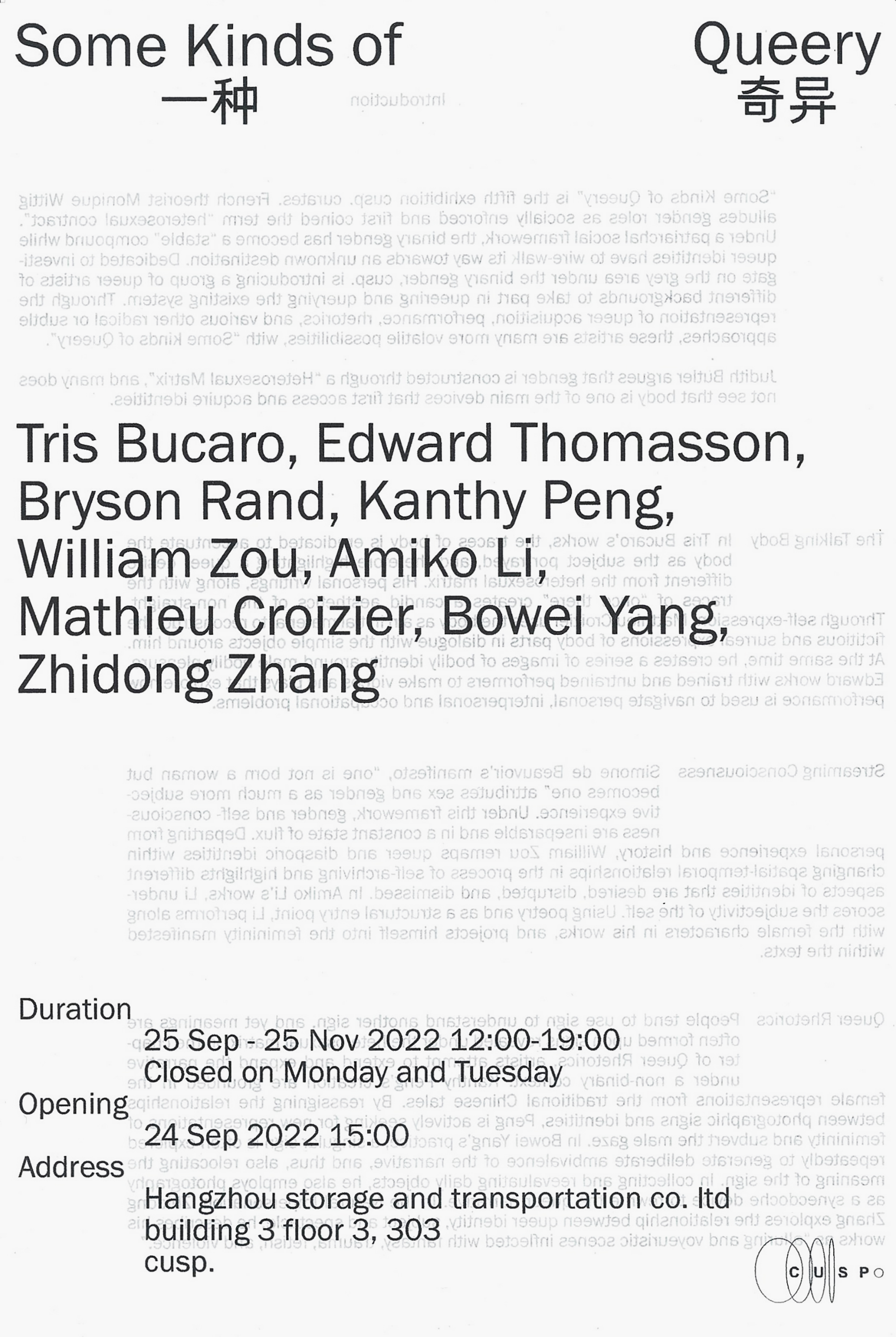
Some kinds of queery
Date:
25 Sep - 25 Nov 2022
12:00-19:00 (Closed on Monday and Tuesday)
Address:
cusp. 79 Fengshan Rd, Hangzhou, China, 310000
Artists :
Tris Bucaro, Edward Thomasson, Bryson Rand, Kanthy Peng(阚辛), William Zou(邹威廉), Amiko Li(李文嘉), Matthieu Croizier, Bowei Yang(杨博炜), Zhidong Zhang(张之栋)
Introduction:
Some Kinds of Queery
In this exhibition, the artist explores and challenges the dichotomous structure of gender discourse through learning, performance, and rhetoric. French theorist Monique Wittig alludes to gender roles as socially enforced and first coined the term “heterosexual contract”. Under a patriarchal social framework, the binary gender has become a “stable” compound while queer identities have to wire-walk their way towards an unknown destination. Dedicated to investigating the grey area under the binary gender, cusp. is introducing a group of queer artists of different backgrounds to take part in queering and querying the existing system. Through the representation of queer acquisition, performance, rhetorics, and various other radical or subtle approaches, these artists are many more volatile possibilities, with “Some kinds of Queery”.
Judith Butler argues that gender is constructed through a “Heterosexual Matrix”, and many do not see that body is one of the main devices that first access and acquire identities.
The Talking BodyDate:
25 Sep - 25 Nov 2022
12:00-19:00 (Closed on Monday and Tuesday)
Address:
cusp. 79 Fengshan Rd, Hangzhou, China, 310000
Artists :
Tris Bucaro, Edward Thomasson, Bryson Rand, Kanthy Peng(阚辛), William Zou(邹威廉), Amiko Li(李文嘉), Matthieu Croizier, Bowei Yang(杨博炜), Zhidong Zhang(张之栋)
Introduction:
Some Kinds of Queery
In this exhibition, the artist explores and challenges the dichotomous structure of gender discourse through learning, performance, and rhetoric. French theorist Monique Wittig alludes to gender roles as socially enforced and first coined the term “heterosexual contract”. Under a patriarchal social framework, the binary gender has become a “stable” compound while queer identities have to wire-walk their way towards an unknown destination. Dedicated to investigating the grey area under the binary gender, cusp. is introducing a group of queer artists of different backgrounds to take part in queering and querying the existing system. Through the representation of queer acquisition, performance, rhetorics, and various other radical or subtle approaches, these artists are many more volatile possibilities, with “Some kinds of Queery”.
Judith Butler argues that gender is constructed through a “Heterosexual Matrix”, and many do not see that body is one of the main devices that first access and acquire identities.
In Tris Bucaro’s works, the traces of the body is eradicated to accentuate the body as the subject portrayed, therefore highlighting a queer desire different from the heterosexual matrix. His personal writings, along with the traces of “once there” creates a candid aesthetics of the non-straight. Through self-expression, Matthieu Croizier uses the body as initial material to reconstruct the fictitious and surreal expressions of body parts in dialogue with the simple objects around him. At the same time, he creates a series of images of bodily identity around male physical pleasure. Edward works with trained and untrained performers to make videos and plays that explore how performance is used to navigate personal, interpersonal, and occupational problems.
Streaming Consciousness
Simone de Beauvoir’s manifesto, “one is not born a woman but becomes one” attributes sex and gender as a much more subjective experience. Under this framework, gender and self-consciousness are inseparable and in a constant state of flux. Departing from personal experience and history, William Zou remaps queer and diasporic identities within changing spatial-temporal relationships in the process of self-archiving and highlights different aspects of identities that are desired, disrupted, and dismissed. In Amiko Li’s works, Li underscores the subjectivity of the self. Using poetry and as a structural entry point, Li performs with the female characters in his works and projects himself into the femininity manifested within the texts.
Queer Rhetorics
People use signs to understand another sign, yet meanings are often formed upon signs revealed under the heterosexual matrix. In the chapter on Queer Rhetorics, artists attempt to extend and expand the narrative under a non-binary context. Kanthy Peng’s creations are grounded in female representations from traditional Chinese tales. By reassigning the relationships between photographic signs and identities, Peng is actively seeking new representations of femininity and subverting the male gaze. In Bowei Yang’s practice, a singular sign is often explored repeatedly to generate deliberate ambivalence in the narrative, thus, also relocating the meaning of the sign. In collecting and reevaluating daily objects, he also employs photography as a synecdoche device to rewrite the queer narrative. In Natural Impersonation, Zhidong Zhang explores the relationship between queer identity, subject, and spectacle, he describes his works as “alluring and voyeuristic scenes inflected with fantasy,
trauma, fetish, and violence.”
Exhibition Credits:
Curated by Bowei Yang, Ruijing Ge, Xiner Xu, Weilian Zou
Visual Design by herbr
Special thanks:Guipiao Hua,Weijia Hu







